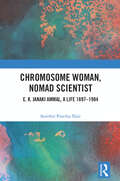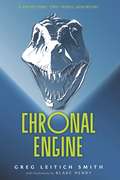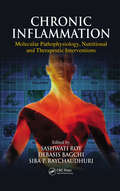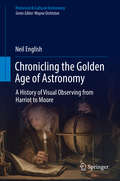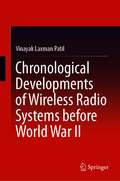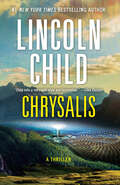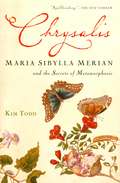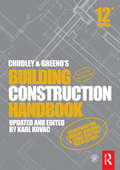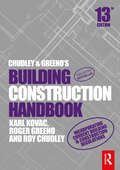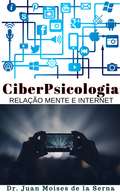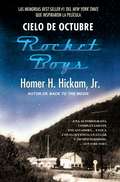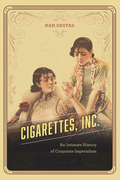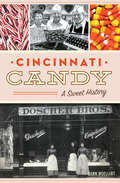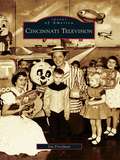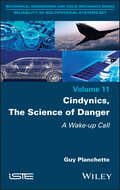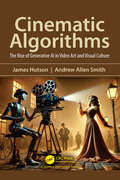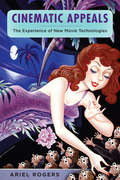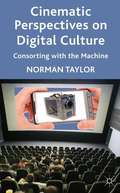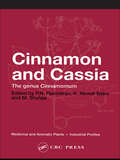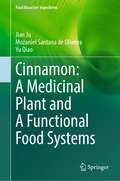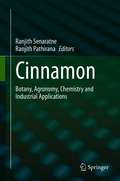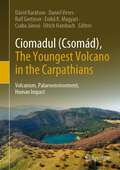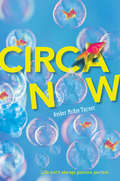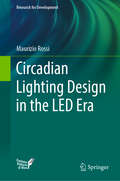- Table View
- List View
Chromosome Woman, Nomad Scientist: E. K. Janaki Ammal, A Life 1897–1984
by Savithri Preetha NairThis is the first in-depth and analytical biography of an Asian woman scientist—Edavaleth Kakkat Janaki Ammal (1897–1984). Using a wide range of archival sources, it presents a dazzling portrait of the twentieth century through the eyes of a pioneering Indian woman scientist, who was highly mobile, and a life that intersected with several significant historical events—the rise of Nazi Germany and World War II, the struggle for Indian Independence, the social relations of science movement, the Lysenko affair, the green revolution, the dawn of environmentalism and the protest movement against a proposed hydro-electric project in the Silent Valley in the 1970s and 1980s. The volume brings into focus her work on mapping the origin and evolution of cultivated plants across space and time, to contribute to a grand history of human evolution, her works published in peer-reviewed Indian and international journals of science, as well as her co-authored work, Chromosome Atlas of Cultivated Plants (1945), considered a bible by practitioners of the discipline. It also looks at her correspondence with major personalities of the time, including political leaders like Jawaharlal Nehru, biologists like Cyril D. Darlington, J. B. S. Haldane and H. H. Bartlett, geographers like Carl Sauer and social activists like Hilda Seligman, who all played significant roles in shaping her world view and her science. A story spanning over North America, Europe and Asia, this biography is a must-have for scholars and researchers of science and technology studies, gender studies, especially those studying women in the sciences, history and South Asian studies. It will also be a delight for the general reader.
Chronal Engine
by Blake Henry Greg Leitich SmithWhen Max, Kyle, and Emma are sent to live with their reclusive grandfather, they think he's crazy, especially when he tells them about his time machine. But after Emma is kidnapped at the exact time that her grandfather predicted, Max and Kyle are forced to believe his eccentric stories--even the one about the Chronal Engine in the basement. Now, to save Emma, Max, Kyle, and their new friend Petra must pile into a VW Bug, and use the Chronal Engine to take the road trip of a lifetime--right back to the Cretaceous period. With dangers all around, the teens find themselves dodging car-crushing herbivores in addition to the terrifying T. rex. In this ancient environment, can three contemporary teens hunt down a kidnapper, forage for food, and survive long enough to return home?
Chronic Inflammation: Molecular Pathophysiology, Nutritional and Therapeutic Interventions
by Debasis Bagchi Siba P. Raychaudhuri Sashwati RoyAlthough acute inflammation is a healthy physiological response indicative of wound healing, chronic inflammation has been directly implicated in a wide range of degenerative human health disorders encompassing almost all present day non-communicable diseases including autoimmune diseases, obesity, diabetes and atherosclerosis. Chronic Inflammation
Chronicling the Golden Age of Astronomy: A History of Visual Observing from Harriot to Moore (Historical & Cultural Astronomy)
by Neil EnglishThe invention of the telescope at the dawning of the 17th century has revolutionized humanity's understanding of the Universe and our place within it. This book traces the development of the telescope over four centuries, as well as the many personalities who used it to uncover brand-new revelations about the Sun, Moon, planets, stars and distant galaxies.Starting with early observers such as Thomas Harriot, Galileo, Johannes Hevelius, Giovanni Domenico Cassini, Robert Hooke and Christian Huygens, the book explores how these early observers arrived at essentially correct ideas concerning the objects they studied. Moving into the 18th and 19th centuries, the author describes the increasing sophistication of telescopes both large and small, and the celebrated figures who used them so productively, including the Herschels, Charles Messier, William Lassell and the Earls of Rosse.Many great discoveries were also made with smaller instruments when placed in the capable hands of the Struve dynasty, F.W. Bessel, Angelo Secchi and S.W Burnham, to name but a few. Nor were all great observers of professional ilk. The book explores the contributions made by the 'clerical astronomers,' William Rutter Dawes, Thomas William Webb, T.E.R Philips and T.H.E.C Espin, as well as the lonely vigils of E.E. Barnard, William F. Denning and Charles Grover. And in the 20th century, the work of Percival Lowell, Leslie Peltier, Eugene M. Antoniadi, Clyde Tombaugh, Walter Scott Houston, David H. Levy and Sir Patrick Moore is fully explored.Generously illustrated throughout, this treasure trove of astronomical history shows how each observer's work led to seminal developments in science, and providing key insights into how we go about exploring the heavens today.
Chronological Developments of Wireless Radio Systems before World War II
by Vinayak Laxman PatilThis comprehensive and authoritative volume traces the history of research leading to the development of the wireless radio systems. It discusses the methods adopted by a large number of inventors and the results they obtained to provide perspective on how historical methods and events can be a source of inspiration for future research. This book will be of interest to researchers and students in telecommunications engineering as well as to teachers of history of science and technology.
Chrysalis: A Thriller (Jeremy Logan Series #6)
by Lincoln ChildA blockbuster new thriller from #1 New York Times bestselling author Lincoln Child, centered on a dominant tech company—Chrysalis—whose groundbreaking virtual reality technology is redefining the way we live . . . and possibly introducing a catastrophic danger to the world.Like millions of people around the world, Jeremy Logan (famed enigmalogist, or investigator of unexplained things) has grown to rely on his incredible new tech device. Made by Chrysalis, the global multibillion dollar tech company, the small optical device connects people in a stunning new way, tapping into virtual reality for the first time on a wide scale. And yet, when Logan is summoned by Chrysalis to investigate a disturbing anomaly in the massive new product rollout, Logan is shocked to see the true scope of the massive company. He also quickly realizes that something in Chrysalis&’s technology is very wrong, and could be potentially devastating. The question is what, and where, is the danger coming from? In Lincoln Child&’s wildly inventive new novel, high tech comes to life alongside the myriad dangers it poses, making for one of Child&’s most infectious, entertaining thrillers to date.
Chrysalis: Maria Sibylla Merian and the Secrets of Metamorphosis
by Kim ToddThe award-winning science and history writer “gives wings to the life of the artist/naturalist Maria Merian. A lovely and exhilarating book” (Deidre McNamer, author of Aviary).Before Darwin, before Audubon, there was Maria Sibylla Merian.An artist turned naturalist known for her botanical illustrations, Merian was born just sixteen years after Galileo proclaimed that the earth orbited the sun. But at the age of fifty, she sailed from Europe to the New World on a solo scientific expedition to study insect metamorphosis—an unheard-of journey for any naturalist at that time, much less a woman.When she returned, she produced a book that secured her reputation, only to have it savaged in the nineteenth century by scientists who disdained the work of “amateurs.”Exquisitely written and illustrated, Chrysalis takes us from golden-age Amsterdam to the Surinam tropics to modern laboratories where Merian’s insights fuel a new branch of biology. Kim Todd brings to life a seventeenth-century woman whose boldness and vision would still be exceptional today.“In this spellbinding biography, Todd interweaves the life of Maria Sibylla Merian, a German artist and naturalist who became famous in the seventeenth century for her engravings of caterpillars, with the intellectual and scientific history of metamorphosis.” —The New Yorker“Fascinating reading about a little-known, independent woman.” —Science“What makes Chrysalis such a pleasure is that our awe is guided by Merian’s discoveries. Her life was dedicated to understanding and depicting the science of transformation, yet she never lost her enchantment with what few of us could deny is also miraculous.” —Orion
Chudley and Greeno's Building Construction Handbook
by Roy Chudley Roger Greeno Karl KovacThe 12th edition of Chudley and Greeno’s Building Construction Handbook remains THE authoritative reference for all construction students and professionals. The principles and processes of construction are explained with the concepts of design included where appropriate. Extensive coverage of building construction practice, techniques and regulations representing both traditional procedures and modern developments are included to provide the most comprehensive and easy to understand guide to building construction. This new edition has been updated to reflect recent changes to the building regulations, as well as new material on modern methods of construction, greater emphasis on sustainability and a new look interior. Chudley and Greeno’s Building Construction Handbook is the essential, easy-to-use resource for undergraduate and vocational students on a wide range of courses including NVQ and BTEC National, through to Higher National Certificate and Diploma, to Foundation and three-year Degree level. It is also a useful practical reference for building designers, contractors and others engaged in the construction industry.
Chudley and Greeno's Building Construction Handbook
by Roy Chudley Roger Greeno Karl KovacThe 13th edition of Chudley and Greeno’s Building Construction Handbook remains THE authoritative reference for all construction students and professionals. The principles and processes of construction are explained with the concepts of design included where appropriate. Extensive coverage of building construction practice, techniques and regulations representing both traditional procedures and modern developments are included to provide the most comprehensive and easy-to-understand guide to building construction.This new edition has been updated to reflect recent changes to the Building Regulations, as well as including new material on modern methods of construction, greater emphasis on sustainability, health and safety, and coverage of heat pumps, photovoltaics, underfloor heating and rainwater harvesting.Chudley and Greeno’s Building Construction Handbook is the essential, easy-to-use resource for undergraduate and vocational students on a wide range of courses including NVQ and BTEC National, through to Higher National Certificate and Diploma, to Foundation and three-year degree level. It is also a useful practical reference for building designers, contractors and others engaged in the construction industry.
CiberPsicologia
by Claudio Vaz Juan Moises de la SernaPrefácio Este livro aborda o novo ramo denominado CiberPiscologia. Ele estuda como se produziu uma mudança na relação pessoa-tecnologia, analisando como os novos desenvolvimentos afetam o dia a dia do homem, bem como a saúde mental de seus usuários. Tudo isso, afiançado por uma extensa bibliografia sobre as últimas pesquisas realizadas neste âmbito. As redes sociais, a Internet e todo o avanço tecnológico dos últimos anos mudou a forma de vermos o mundo e de nos comportarmos. Uma mudança, em muitos casos, radical, que não podia passar despercebida à Psicologia, ciência do estudo do comportamento humano. O invento e o manejo de ferramentas como o machado ou a agulha, primeiro, e máquinas como o carro ou o computador, posteriormente, revolucionaram a forma de relacionamento consigo mesmo e com os demais. Para falar com um familiar ou amigo, basta conectar-se no Skype e que a outra pessoa esteja disponível, independentemente do lugar onde se encontrem. Foram muitos e rápidos os avanços tecnológicos que ocorreram nas últimas décadas, o que obrigou as pessoas, os usuários dessa tecnologia, a se adaptarem a ela para poder, assim, aproveitá-la. Objetivo: O objetivo do livro é servir como primeira aproximação ao ramo emergente da psicologia denominado CiberPiscologia. Para isso, tratam-se dos temas mais relevantes, oferecendo resultados sobre recentes pesquisas, desenvolvidas nos últimos 2 anos, ao redor do mundo sobre esta matéria. Tudo explicado com uma linguagem clara e simples, longe de tecnicismos, explanando cada conceito de forma que possa servir como um verdadeiro guia de iniciação. Destinatários: - Profissionais de saúde que têm de enfrentar uma clínica cada vez mais complexa pelos recentes casos provocados pelo uso e abuso da internet e das novas tecnologias. - Professores que procuram se atualizar sobre as mudanças que observam em seus alun
Cielo de octubre (Rocket Boys)
by Homer HickamAsí comienza la maravillosamente entretenida y extraordinaria autobiografía de la vida de «Sonny» Homer Hickam, Jr. en Coalwood, Virginia Occidental, un pueblo miserable donde lo único que importaba era la minería de carbón y el fútbol americano. El segundo hijo introspectivo del superintendente de la mina y de una madre decidida a alcanzar una vida mejor para su hijo, Sonny se unió a un grupo de inadaptados para quienes el futuro parecía incierto. Pero en 1957, luego de haber visto el satélite soviético Sputnik cruzar el cielo de los Apalaches, Sonny y sus amigos adolescentes tomaron el futuro en sus manos, cambiando sus vidas y su ciudad para siempre.Recordando una carrera distinguida en la NASA que hizo realidad los sueños de su niñez, Hickam relata la historia de su juventud, llevando a los lectores a la vida de aquel pueblo minero y las de los muchachos que encarnaron sus tensiones y sus sueños. Con la ayuda —y en ocasiones los obstáculos— de los habitantes de Coalwood, los jóvenes aprendieron no solo a convertir escombros de minería en cohetes que surcaban los cielos, sino que encontraron esperanza en una ciudad en la que el progreso pasaba desapercibido.Una autobiografía única, Cielo de octubre es a la vez una crónica inspiradora de triunfo y una historia luminosa del amor de una madre, los temores de un padre y la vida de un joven.Con la sencilla gracia de un narrador por naturaleza, Homer Hickam capta a la perfección un momento en el cual un pueblo agonizante, una familia dividida y una banda de adolescents soñadores se atrevieron a mirar más allá de sus diferencias y a fijar sus objetivos en las estrellas... y vieron un futuro que la nación estaba apenas empezando a imaginar.
Cigarettes, Inc.: An Intimate History of Corporate Imperialism
by Nan EnstadTraditional narratives of capitalist change often rely on the myth of the willful entrepreneur from the global North who transforms the economy and delivers modernity—for good or ill—to the rest of the world. With Cigarettes, Inc., Nan Enstad upends this story, revealing the myriad cross-cultural encounters that produced corporate life before World War II. In this startling account of innovation and expansion, Enstad uncovers a corporate network rooted in Jim Crow segregation that stretched between the United States and China and beyond. Cigarettes, Inc. teems with a global cast—from Egyptian, American, and Chinese entrepreneurs to a multiracial set of farmers, merchants, factory workers, marketers, and even baseball players, jazz musicians, and sex workers. Through their stories, Cigarettes, Inc. accounts for the cigarette’s spectacular rise in popularity and in the process offers nothing less than a sweeping reinterpretation of corporate power itself.
Cincinnati Candy: A Sweet History
by Dann WoellertFor more than a century, Cincinnati’s candy industry satisfied our national sweet tooth. Stick and drop candies appeared here long before their Civil War popularity. Opera creams, rich fondant-filled chocolate candy brought here by Robert Hiner Putman, provided decadence. Candy corn, which the Goelitz Company introduced to the United States before World War I, remains a ubiquitous treat. Marpro Products created and popularized the marshmallow cone candy. Doscher invented the French Chew and made caramel corn a baseball concession at Redland Field decades before Cracker Jack became synonymous with our national pastime. The city’s many Greek and Macedonian immigrants influenced the unique Queen City tradition of finishing a Cincinnati-style “threeway” of spaghetti, chili and cheddar with a chocolate mint. Local food etymologist Dann Woellert tells these stories and more in this delectably sweet history.
Cincinnati Television (Images of America)
by Jim FriedmanCincinnati has a distinguished television history. Beginning before WLW-T signed on the air in February 1948, its experimental station W8XCT broadcast from the 46th floor of the Carew Tower. WKRC-TV and WCPO-TV signed on in 1949, WCET in 1954, and WXIX-TV in 1968. Since then, television has become part of the family. Uncle Al, Skipper Ryle, Batty Hattie from Cincinnati, the Cool Ghoul, Peter Grant, Al Schottelkotte, Nick Clooney, Ruth Lyons, Paul Baby, Bob Braun, and Jerry Springer visited Cincinnati living rooms on television. Remember Midwestern Hayride, TV Dance Party, PM Magazine, Juvenile Court, Young People's Specials, Lilias, Dotty Mack, Bob Shreve, Mr. Hop, Bean's Clubhouse, The Last Prom, and Ira Joe? They are part of the collective Cincinnati history, part of the Cincinnati culture, and part of the Cincinnati family.
Cindynics, The Science of Danger: A Wake-up Call
by Guy PlanchetteThis book offers a new perspective to uncover the keys to accident and disaster avoidance. Created with a working group, it presents research and understanding on the root causes of disasters. Indeed, beyond technical failures, human beings are at the heart of organizations and, through the exchange of data and information, influential relationships inevitably emerge such as conflicts of interest and cooperation.With examples selected from multiple accidents and disasters, this book demonstrates that analyzing the causal chain that leads to an accident is not sufficient if we wish to truly understand it. The role of operational and managerial actors and the complexities they generate are also explored.Cindynics, The Science of Danger helps readers develop their ability to identify gaps, deficits, dissonances, disjunctions, degenerations and blockages, which are the real dangers in inevitably evolving activity situations. With an easily-understandable approach, this book offers new perspectives in several fields (health, crisis management and conflict resolution).
Cinematic Algorithms: The Rise of Generative AI in Video Art and Visual Culture
by Andrew Smith James HutsonThis book explores the groundbreaking integration of generative artificial intelligence into filmmaking and visual storytelling. From democratizing video production to reshaping aesthetics, this book highlights the creative revolution AI offers. Through case studies, interviews with innovative artists, and historical perspectives, it examines how intelligent systems enhance creativity while challenging traditional notions of authorship and originality. With practical guides and forward-looking insights, this volume is essential for anyone curious about the intersection of technology and visual culture, offering a vivid portrait of the future of storytelling in an AI-driven world.
Cinematic Appeals
by Ariel RogersCinematic Appeals follows the effect of technological innovation on the cinema experience, specifically the introduction of widescreen and stereoscopic 3D systems in the 1950s, the rise of digital cinema in the 1990s, and the transition to digital 3D since 2005. Widescreen films drew the spectator into the world of the screen, enabling larger-than-life close-ups of already larger-than-life actors. The technology fostered the illusion of physically entering a film, enhancing the semblance of realism. Alternatively, the digital era was less concerned with manipulating the viewer's physical response and more with generating information flow, awe, disorientation, and the disintegration of spatial boundaries. This study ultimately shows how cinematic technology and the human experience shape and respond to each other over time. Films discussed include Elia Kazan's East of Eden (1955), Star Wars: Phantom Menace (1999), The Matrix (1999), and Thomas Vinterberg's Dogme film Celebration (1995).
Cinematic Appeals: The Experience of New Movie Technologies (Film and Culture Series)
by Ariel RogersCinematic Appeals follows the effect of technological innovation on the cinema experience, specifically the introduction of widescreen and stereoscopic 3D systems in the 1950s, the rise of digital cinema in the 1990s, and the transition to digital 3D since 2005. Widescreen cinema promised to draw the viewer into the world of the screen, enabling larger-than-life close-ups of already larger-than-life actors. This technology fostered the illusion of physically entering a film, enhancing the semblance of realism. Alternatively, the digital era was less concerned with the viewer's physical response and more with information flow, awe, and the reevaluation of spatiality and embodiment. This study ultimately shows how cinematic technology and the human experience shape and respond to each other over time.
Cinematic Perspectives on Digital Culture
by Norman TaylorExploring research into mobile phone use as props to subjective identity, Norman Taylor employs concepts from Michelle Foucault, Gilles Deleuze and actor network theory to discuss the affect of mechanisms of make-believe, from celebrity culture to avatar-obsessed game players, and digital culture.
Cinnamon and Cassia: The Genus Cinnamomum (Medicinal And Aromatic Plants S. - Industrial Profiles Ser.)
by P. N. Ravindran K. Nirmal Babu M. ShylajaCinnamon and Cassia, the "Spices of Life", together constitute one of the most widely used group of spices. A comprehensive volume, Cinnamon and Cassia: Genus Cinnamomum explores in detail Srilankan cinnamon, Chinese cassia, Indonesian cassia, Indian cassia, camphor, and also the important related and useful spices of Cinnamomum.The introdu
Cinnamon: A Medicinal Plant and A Functional Food Systems (Food Bioactive Ingredients)
by Yu Qiao Mozaniel Santana de Oliveira Jian JuThis work addresses the multiple possibilities for using cinnamon for applications in food science technology and to help in the complimentary treatment and prevention of diseases, with priority given to secondary metabolites produced by this plant. Issues related to the functions of cinnamon and its applications, as well as the biosynthetic pathways of production by plants, are covered in depth. The link between food science and technology and specific medicinal plants has not been explored enough in the current literature, and this text looks to bridge this gap in its extensive coverage of cinnamon. CINNAMON: A Functional Food and Medicinal Plant provides readers with a broad and diverse overview of the importance of secondary metabolites produced by plants and the possibilities for innovative biotechnological approaches that introduce new potential to a wide range of industrial products. The application of cinnamon in products across food science and its numerous health benefits are outlined, including its use as a complimentary medicine for a number of diseases. This book features the main cinnamon varieties and production areas plus quality evaluation and bioactive compound extraction methods. The multiple applications of spices in foods are covered in depth, plus antioxidant activity and inhibitory effects on bacteria and fungi. Beyond its use in foods, readers will find chapters covering the antiviral effects of cinnamon and its use for the treatment and prevention of diabetes and other disorders. Also important is coverage on the safety aspects of cinnamon and its extracts. To date no book has exclusively covered the many uses of cinnamon and cinnamon extracts in food and pharmaceutical applications. This much-needed work provides a fully up to date and extensive overview for researchers to examine the many uses of cinnamon across multiple products and industries.
Cinnamon: Botany, Agronomy, Chemistry and Industrial Applications
by Ranjith Senaratne Ranjith PathiranaCinnamon is the common name for the spice obtained from the dried inner bark of several species of the genus Cinnamomum in the Lauraceae family. In world trade, Cinnamomum cassia (L.) J. Presl Cinnamomum burmannii dominate, but it is of a different quality to ‘true’ or ‘Ceylon’ cinnamon produced from Cinnamomum zeylanicum Blume (C. verum J. Presl), with the latter much easier to process, giving a more delicate, sweeter flavor with nuances of clove, but more importantly with only traces (often below detection thresholds) of coumarin, compared with 5–7 g/kg in other species. Cinnamon has been a popular and expensive spice in many civilizations, including ancient Egypt, Rome and in 14th and 15th century Europe, where it was used primarily to preserve meat for its antibacterial properties, fine aroma and flavor. Ancient Egyptians used cinnamon in mummification process due to its antibacterial properties and fragrance. The quest for cinnamon brought many explorers to Ceylon, whose ancient history is intertwined with the cinnamon trade. Ancient Egyptians and Romans used cinnamon as a valued spice and as an incense.In recent years, much research has been conducted in crop improvement, processing and value addition in cinnamon. In addition to direct use as a condiment/spice, cinnamon has found a multitude of uses in the food and beverage, traditional medicine, pharmacology, nutraceutical and cosmetics industries. Ceylon cinnamon is unique in that oils distilled from the bark (major constituents are cinnamaldehyde and oleoresins), leaf (eugenol is the major constituent used in dentistry, perfumes, flavorings and as an antioxidant) and roots (camphor) have different industrial uses. Cinnamaldehyde is now a proven natural bactericide widely used in food and beverage industry, effective against Salmonella spp. and Escherichia coli. Thus, it has become an important natural component of organic fruit and vegetable juices to enhance microbial safety of these nutritious beverages.Because of its manifold uses, cinnamon is an important crop. There have been many recent publications on its ethnobotany, genetics, crop improvement, agronomy, processing, biotechnology, chemistry, food and medicinal uses, and industrial applications. However, one book condensing all these findings is lacking. Our publication, with chapters devoted to all these aspects of cinnamon written by experts in these fields, condenses current knowledge into a single source and contribute to the advancement and dissemination of knowledge and technology. Contributors to the book constitute internationally renowned senior scientists and academics with hands-on experience as well as movers and shakers of industry, thereby striking a right balance between theory and practice. Therefore it is a valuable source for students, teachers, scientists, planners policy makers, practicing agriculturists and industrialists, and a prized acquisition to any library in higher education institutions, R & D institutions and public and private sector institutions in agriculture and allied fields.
Ciomadul (Csomád), The Youngest Volcano in the Carpathians: Volcanism, Palaeoenvironment, Human Impact
by Dávid Karátson Daniel Veres Ralf Gertisser Enikő K. Magyari Csaba Jánosi Ulrich HambachThis book delivers the present state-of-the-art of scientific characteristics of the unique Ciomadul volcano (Romania, East-Central Europe) from as many aspects as possible.. Multidisciplinary research results obtained on this geologically young volcanic complex are presented to a wider audience (geologists, volcanologists, botanists, archaeologists, historians and teachers). Moreover, the book provides information at a general level for interested laypersons and decision-makers. The first part of the book, after summarizing the research history of Ciomadul, presents the details of the volcanism and related topics (volcanology, geology, landscape evolution, minerals, post-volcanic activity and spa culture) in eight chapters; the second part deals with the palaeo-environmental issues of the larger area, along with human history, in nine chapters.
Circa Now
by Amber McRee TurnerTwelve-year-old Circa Monroe has a knack for restoring old photographs. It's a skill she learned from her dad, who loves old pictures and putting fun digital twists on them. His altered "Shopt" photos look so real that they could fool nearly anybody, and Circa treasures the fun stories he makes up to explain each creation. One day, her father receives a strange phone call requesting an urgent delivery, and he heads out into a storm. The unimaginable happens: a tornado, then a terrible accident, and Circa never sees her dad again. Just as Circa and her mom begin to pick up the pieces, a mysterious boy shows up on their doorstep, a boy called Miles who remembers nothing about his past. The only thing he has with him is the photograph that Circa's dad intended to deliver on the day he died. As Circa tries to help Miles recover his identity, she begins to notice something strange about the photos she and her father retouched???the digital flourishes added to the old photos seem to exist in real life. The mysteries of the Shopt photos and Miles's past are intertwined, and in order to solve both, Circa will have to figure out what's real and what's an illusion. With stunning prose, captivating photographs, and a hint of magic, Circa Now is a gripping story full of hope and heart.
Circadian Lighting Design in the LED Era (Research for Development)
by Maurizio RossiThis book explores how lighting systems based on LED sources have the ability to positively influence the human circadian system, with benefits for health and well-being. The opening chapters examine the functioning of the human circadian system, its response to artificial lighting, potential health impacts of different types of light exposure, and current researches in circadian photometry. A first case study analyzes the natural lighting available in an urban interior, concluding that it is unable to activate the human circadian system over the entire year. Important original research is then described in which systems suitable for artificial circadian lighting in residential interiors and offices were developed after testing of new design paradigms based on LED sources. Readers will also find a detailed analysis of the LED products available or under development globally that may contribute to optimal artificial circadian lighting, as well as the environmental sensors, control interfaces, and monitoring systems suitable for integration with new LED lighting systems. Finally, guidelines for circadian lighting design are proposed, with identification of key requirements.
